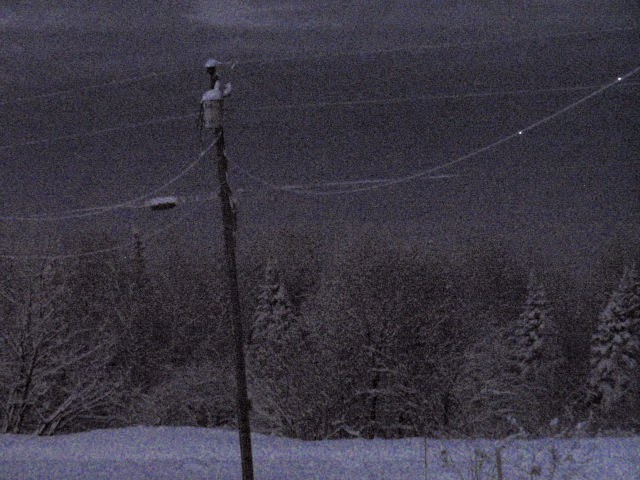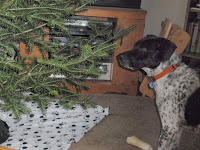 |
| After the storm |
 |
| Bringing in the tree |
We are taking down the Christmas
tree today; packing away the ornaments we have made and collected over nearly
four decades. It is time to take out the tree that we cut and brought in during
near blizzard conditions. We will deck
it with strings of cranberries and hang a suet block on it to tempt the downy
woodpeckers, chickadees, and the shy whisky jays who just this year have begun
venturing from the fir trees and into the yard, lured by seeded suet hung in
the small birch and apple trees. I have
taken the Christmas cards that we received down from the mantel, made note of
the friends who sent them, and packed them away to be turned into gift tags and
other crafts for next year.
Beyond the windows, the sky is low
and gray, the wind out of the southwest, promising another storm adding inches
to the smooth blanket of white spread across our piece of the world. Fifty-four inches of snow have fallen thus
far this year, according to my husband who carefully measures and records each
accumulation, and though much of it melted away earlier in the season, the
nearly two feet that are on the ground make for difficult travel without snowshoes,
skis or good snow tires.
The pace of
life slows, and is marked by bringing in sled loads of wood every couple days
to keep the fire burning and checking the weather sources so we can plan our
trips to town around the storms. The
dogs hunker down, content with a mad dash around the snow-covered, subzero
backyard before bounding back inside to stretch beside the hearth or curl up on
the bed buried in fleeces. Life
slows. It is a time of common chores
and limited activities, and a time of reflection: looking ahead and looking
back.
 |
| Dog in snow |
Janus, the two-headed Roman god,
appropriately provides the inspiration for January, ushering out the old,
welcoming in the new. We look back on
that which the past year has brought us, and look forward, sometimes foolishly,
to what the next year will bring. When I
was young, I was sure that such things were within my control. All it took was
a simple resolution and good things would come to past. The years have taught me that although well
intentioned, such thinking is not true. Life is bumpy, messy, and the best made
resolutions often come to naught. And so we bid a relieved goodbye to the
passing year which has been filled with trials and triumphs, joy and sorrow,
success and failure, and we move forward, cautiously optimistic of success and
braced for disappointment.
 |
| My mom on Christmas |
This
past year has been difficult, full of change and realization. My mother, who
lives right next door to us, has struggled increasingly with the challenges
that aging brings. Her memory has
faltered and time has become elusive and capricious. Five minutes, five days, five years are all
the same to her. Names of old friends and loved ones slip away without warning
and the impact affects those who love her most and are closest to her. Her physical stamina wanes with each day, and
she naps more often, cares little for the knitting and other activities that
once filled her hours. Cumulatively, she is alternately sad and enraged. Watching her struggle makes us mindful of our
own vulnerability to aging, and we rush about our own daily tasks with new
determination to somehow hold off the inevitable advance of days, while knowing
that somehow, no matter our commitment, we too will face the abandonment of
things we love simply because of the frailty of being human.
But all is not lost as this
beginning of yet another year brings joy and planning for the future, too. The snow buntings have arrived, and every
morning a breakfast club of about thirty of these small birds gathers in out
driveway to feast on the seed we toss out for them. Cornell University’s ornithology lab advises
that these are birds of the High Arctic and snowy fields. I guess on both
counts we near qualify. Mostly white
with hints of gingery buff and grey, these little birds are often called
snowflakes because a flock of them seem to drop from the sky when they settle
to eat or gather grit from the sand the town puts on the road to counter the
icing that inevitably occurs.
Before the
snow buries the dried heads of weeds, the birds fling themselves against the
stalk to knock down the seeds, and then burrow into the snow to find their fallen
food. We spend hours watching them, and
over the years, they have become so used to our feeding them that if Bruce does
not get out early enough in the morning, they light in the popples across the
road and raise a cacophonous clatter, quieting only when they see the garage
door rise. We’ve been told that their
coming within a dozen feet of the house is unusual as they are shy birds, and
they are easily spooked if we pass too close to the windows while they are
feeding. They rise together in one
smooth spiral and wing back to the popples where they sit and complain until
they are sure it is safe to return. We spend hours watching them.
 |
| The breakfast club |
The day that the mailman brings the
first seed catalogs is a day of rejoicing, a sure promise that as the days grow
longer and the cold grows stronger, spring too inches its way into our daily
lives. Years ago, a guaranteed Christmas present was a new box of colored
pencils and a pad of graph paper so I could plan out the summer garden. Recently we’ve become more efficient, using
large sheets of graph paper to plan, and saving the plans from one year to
another so we can rotate various vegetables through the garden.
Because
we grew for the farmers’ market for several years, we get a several dozen seed
catalogs, but we are picky about where we get our seeds. They must be organic
and non-GMO, both because we aren’t convinced that modifying what we eat does
not impact our health and in honor of Jim Gerritsen of Wood Prairie Farm in
Bridgewater who championed the GMO fight against Monsanto. We’re blessed to have one of the best, Fedco
Seeds, here in Maine, but we also buy from High Mowing Seeds in Vermont,
Southern Exposure Seed, Seedsavers, and Richter’s out of Ontario, Canada. This year, daughter Kasey sent a link to a list
of heirloom seed companies (http://www.off-grid.info/food-independence/heirloom-seed-suppliers.html)
that I will peruse too.
We
like these old fashioned varieties because they remind us of the food we ate as
children and usually have better flavor.
I can spend hours pouring over colored photos of emerald broccoli, ruby
tomatoes, golden corn, and a wealth of others. We grow much of the food we eat
year round, organically, and want to make sure we get great yield and great
flavor. The efforts are never
disappointing, and it’s a wonderful way to spend a day like today.
Outside
the skies are low and gray, and a large squall that dropped another half inch
of snow has gone past, heading east to New Brunswick. Crown of Maine Weather, which we often turn
to for accurate forecasts, shows that tonight into tomorrow may be rough with more
heavy snow, so we bring in a bit more firewood and plan a hearty supper. There is bread in the machine, and homemade
beef pot pie on the menu. While this
sounds difficult, it’s really quite easy and is so soul-satisfying that
everyone should try their hand at it.
Best of all, we’re using leftovers from Christmas dinner to put it all
together.
Beef Pot Pie
One
9-inch pie crust
1
c. turnip, cooked and in chunks
1
c. cubed potatoes, cooked
1/2
cup frozen peas
I
c. carrots, sliced and cooked
1
stalk celery, minced
1
medium onion, minced
2
cloves garlic, minced
6
Tbls. butter or beef drippings
6
Tbls. flour
2
c. burgundy wine
2
c. brown beef stock
Leftover
beef gravy if you have it
3
strips good bacon, chopped in pieces
2-3
lbs beef, in chunks
Preheat
oven to 375 degrees. In a large pot over medium high heat, sauté the bacon
pieces, stirring often, until crisp to render fat. Remove from pot and set aside. Brown beef chunks if necessary, then remove
and set aside. If you have leftover beef
roast, you do not have to brown the beef.
Sauté
celery, onion and garlic in bacon fat for 2 to 3 minutes or until just tender.
Add
butter to pot and melt, then mix in flour to create a roux. Add in burgundy and
then the brown stock, and whisk to blend well, and stir until it comes to a
boil. Reduce heat. If you have leftover gravy, add it now, and
return sauce to a gentle boil. Cook until it thickens a bit more and then
remove pot from heat. Stir in beef chunks and then turnip, potatoes, carrots,
and peas. Stir to mix Adjust seasonings and pour into a large heavy casserole
(10-inch diameter by at least 3 inches high.
Cut
vents in the pie crust and lay on top of beef/vegetable/gravy mix. Place in hot oven and cook until crust is
golden brown – about 45 minutes.
Best
served with warm crusty bread to mop up the gravy.
This dish is somewhat thrown
together, so take latitude with both the ingredients and the preparation, but
don’t by-pass the beef pot pies of childhood simply because the preparation
looks complex. I have known some to use
canned gravy and frozen veggies to throw this together and the results have
been wonderful.
Beyond the window, a few flakes are
falling, and the western sky is low and dark. Bruce has laid the fire and the
dogs doze in their chairs, paws twitching in their dreams. The house smells of beef and gravy and yeasty
bread. We are prepared for whatever this
next storm brings, but we think of the linesmen still out in the cold, racing
to get power back to homes that have been dark now for as much as a week. We offer a silent prayer to the storm gods
and hope that all get home before the gale begins, and as we inch toward the
New Year and new possibilities, we wish you all the happiest of
dreams and hope that all your dreams come true.
 |
| For me? |
 | |
| Did I hear sleigh bells? |
.












